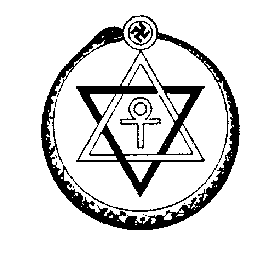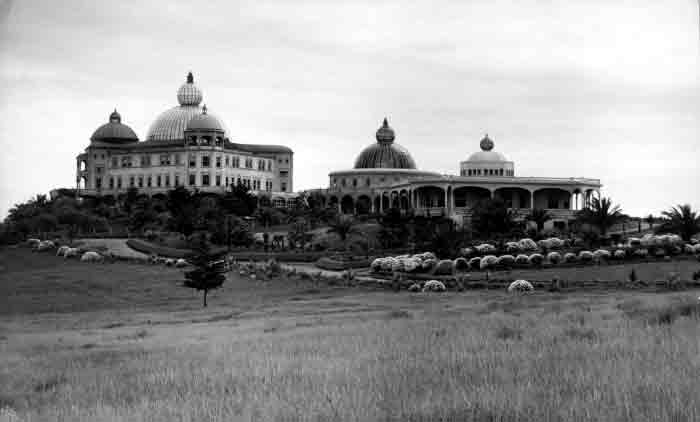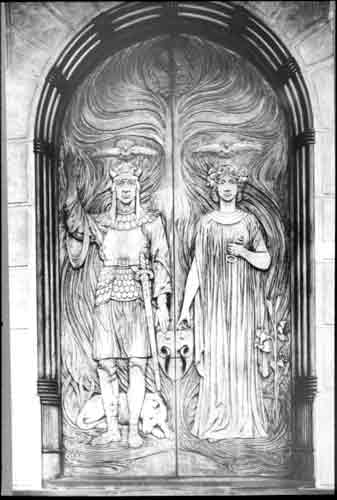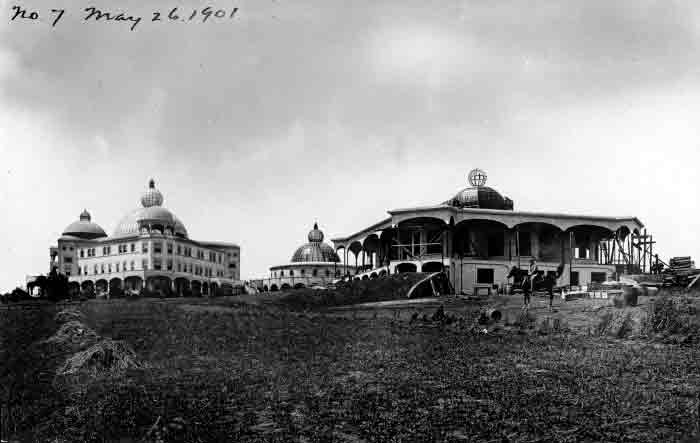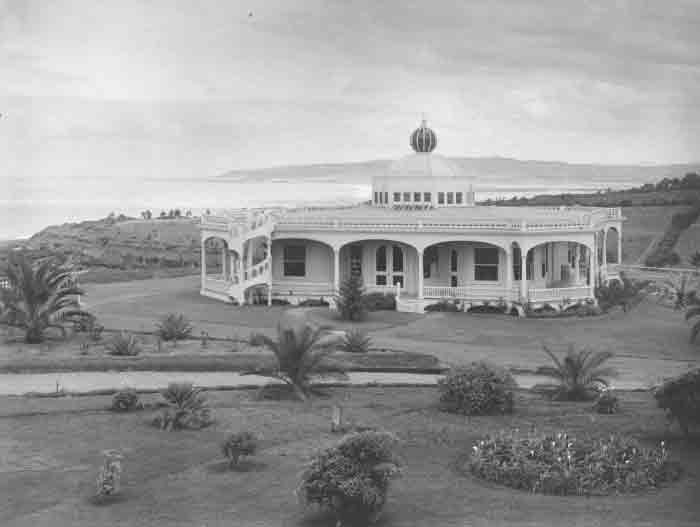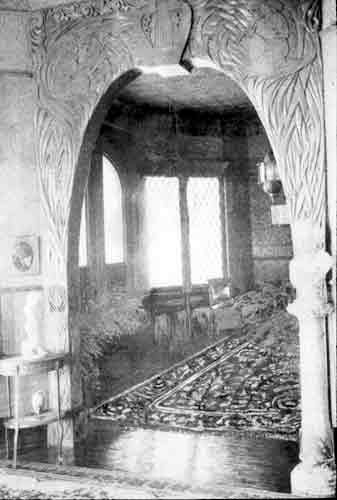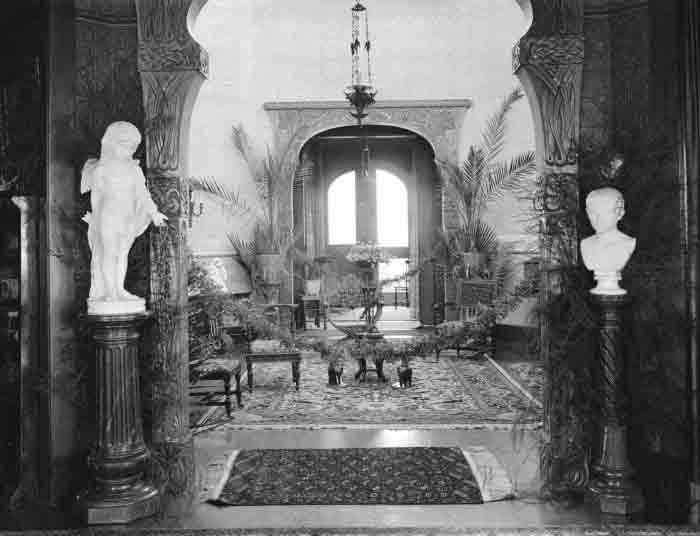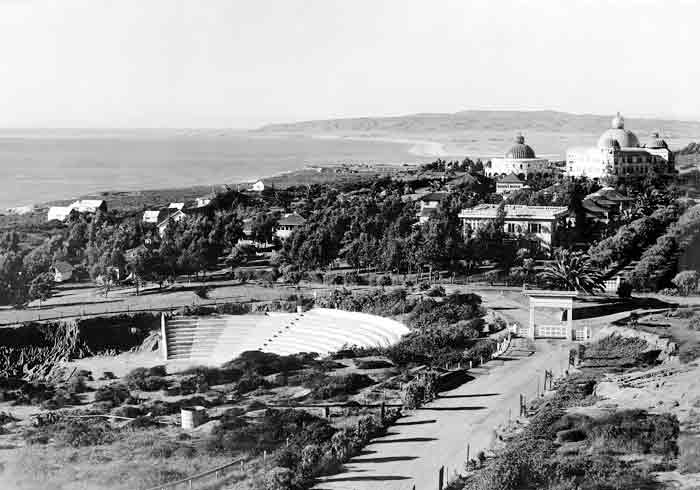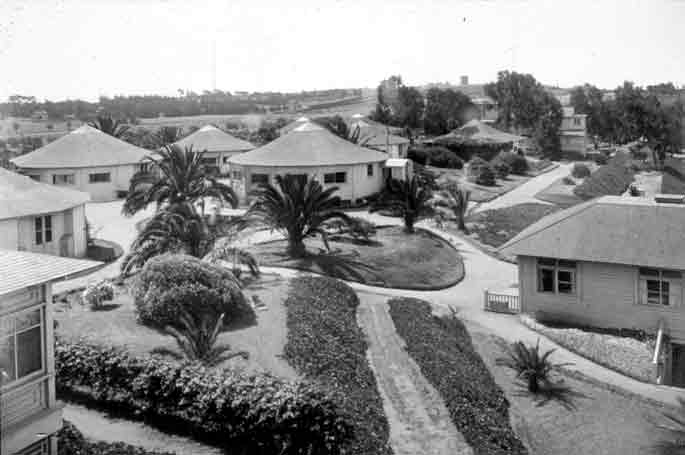FOCUS ON THE FAMILY
TIES TO
THE THEOSOPHICAL SOCIETY
The present campus of Point Loma Nazarene University in San Diego, CA was first established in 1897 as the Point Loma Universal Brotherhood and Theosophical Society Homestead – also known as Lomaland – an educational site of the Theosophical Society of America. Subsequent to its foreclosure in 1941, the Point Loma campus has been occupied by Balboa University (1950), California Western College (1952) and the United States International University (1968) – the same university with changed names.
In 1973, the Church of the Nazarene’s Pasadena College sold 38+ acres of land in Pasadena to U.S. Center for World Mission and relocated to the Point Loma campus, becoming the Point Loma Nazarene College and later Point Loma Nazarene University. Although the Theosophical Society’s Lomaland property was foreclosed in 1941 and Pasadena College did not purchase the Point Loma site until 1973, there appear to be ongoing connections between Point Loma Nazarene University (PLNU), the Theosophical Society (TS) and Focus on the Family (FOTF):
In 1897, the Point Loma Universal Brotherhood and Theosophical Society Homestead (Lomaland) was established in Point Loma, California as the educational site of the Theosophical Society of America
In 1941, the Point Loma Universal Brotherhood and Theosophical Society Homestead relocated to Pasadena, CA where it became the International Headquarters of the Theosophical Society
In 1950, Theosophical Society Lomaland property was sold to Balboa University, renamed California Western College and later the United States International University (Wikipedia)
In 1958. James Dobson graduated from Church of the Nazarene Pasadena College (renamed Point Loma Nazarene University)
In 1960, Shirley Dobson graduated from Church of the Nazarene Pasadena College/Point Loma Nazarene University
In 1968, James Dobson returned to Church of the Nazarene Pasadena College/Point Loma Nazarene University
In 1971, Dr. James Dobson received the Distinguished Achievement Award of the Point Loma Nazarene University
In 1973, the Church of the Nazarene Pasadena College property, located 2 mi. from Theosophical Society Headquarters, was sold to the US Center for World Mission and the college relocated to the Point Loma peninsula in San Diego where it was renamed Point Loma College: An Institution of the Church of the Nazarene
In 1983, Point Loma College: An Institution of the Church of the Nazarene was renamed Point Loma Nazarene College
In 1992, a conference of The Theosophical Society was held at Point Loma Nazarene College
In 1998, Point Loma Nazarene College was renamed Point Loma Nazarene University (PLNU).
In 2000, Shirley Dobson was given the PLNU Distinguished Achievement Award
In 2001, H. B. London, cousin of James Dobson and executive of FOTF, was Master of Ceremony for the PLNU Alumni Association “farewell to the [Pasadena] campus” event.
The following Timelines show the interactivity between the Theosophical Society, Point Loma Nazarene University [PLNU] and Focus on the Family.
PLNU Affiliation with Church of the Nazarene [& Oxford University]
History of Theosophical Society
Combined Chronology showing interaction between PLNU and TS
H.B. London & the Liberal Catholic Church
The Liberal Catholic Church & Theosophical Society
POINT LOMA NAZARENE UNIVERSITY HISTORY
1895 - Dr. Phineas F. Bresee, a minister of the Methodist Episcopal Church, and Dr. J.P. Widney, a Methodist layman and former President of the University of Southern California, founded the Church of the Nazarene in Los Angeles. [Shirley and James Dobson graduated from USC]
1902 - Dr. Bresee founded Pacific Bible College in Los Angeles, California to train ministerial and lay leadership for the new denomination. Pacific Bible College is the predecessor of Point Loma Nazarene University.
1910 - Pacific Bible College purchased the Hugus Ranch property in Pasadena, California, and moved the campus to the Pasadena site. The school included liberal arts and grew as Pasadena College.
1973 - Pasadena College was relocated on the historic Point Loma peninsula in San Diego where it thrived for ten years as Point Loma College: An Institution of the Church of the Nazarene.
1983 - Point Loma College: An Institution of the Church of the Nazarene was changed to Point Loma Nazarene College.
1998 - Point Loma Nazarene College was changed to Point Loma Nazarene University.
POINT LOMA NAZARENE UNIVERSITY / CHURCH OF THE NAZARENE AFFILIATION
Point Loma Nazarene University is the official University of the Southwest Educational Region of the Church of the Nazarene. The relationship of the University and the Church of the Nazarene is characterized by a mutual commitment to the doctrine and mission.
The Church of the Nazarene is an international Protestant denomination in the holiness tradition. The Church is firmly Wesleyan in doctrine and evangelical in mission. Its polity is representative. Emphasis is given to the conversion of sinners, the entire sanctification of believers, and the spreading of the gospel to every person. The Church is a member of the Christian Holiness Association and the National Association of Evangelicals.
NOTE: No Statement of Faith could be found on the Church of the Nazarene website, however...
The Church of the Nazarene [dead link]
-
September 30, 1999 - Church of the Nazarene Joins the World Methodist Council. (Wikipedia) The World Methodist Council is a member of the interfaith World Council of Churches, which is a non-governmental organization (NGO) of the United Nations.
-
Many World Methodist Council activities are undertaken through auxiliaries, such as the Oxford Institute ...
-
Nazarenes have been involved in several of these auxiliaries for many years. Nazarenes have participated in the Oxford Institute since 1976, for instance, and Dr. Maxine Walker, head of the Wesleyan Center for 21st Century Studies at Point Loma Nazarene University, serves currently on the Oxford Institute's planning committee. (Maxine Walker, Ph.D., Emeritus Professor of Literature, Point Loma Nazarene University. Dr Walker has recently retired as Director of the Wesleyan Center for 21st Century Studies (Manchester Wesley Research Center)
The Oxford Institute is the Oxford Institute of Methodist Theological Studies at Oxford University in England.
Oxford University was founded by the Ancient Order of Druids
Oxford University was the center for the Oxford Movement, the 19the century Counter-Reformation in England
Oxford University is the training center for Rhodes Scholars
Oxford University is an international hub for Evangelical theological education (See: Oxford Centre for Mission Studies)
HISTORY OF POINT LOMA NAZARENE UNIVERSITY CAMPUS
"The main campus of approximately 90 acres was first established as an educational site [Lomaland – see 1900] by the Theosophical Society of America and has been occupied since by Balboa University, California Western College, and United States International University." [same university with changed names]. The early occupants of this campus erected a number of wooden buildings, some of which are still in use... Several campus buildings are of historical interest. Among these are the Greek Amphitheatre, first of its type to be built in the United States; Mieras Hall, built in 1901 by the Spalding family; and Cabrillo Hall, originally the home of Madame Katherine Tingley, leader of the Theosophical Society." (See PLNU Campus Tour below)
HISTORY OF THEOSOPHICAL SOCIETY
1896 - Katherine Tingley was recognized successor to William Q. Judge, Vice President of the TS and General Secretary of its American Section, with international headquarters at first in New York City. Willim Q. Judge had succeeded Annie Besant and Henry Steel Olcott who had co-founded the Theosophical Society with H. P. Blavatsky.
1900 - Tingley moved the international headquarters to Point Loma, California, where she established the Raja-Yoga School, Academy and College; Theosophical University; and the School for the Revival of the Lost Mysteries of Antiquity.
1909 - group spearheaded by Robert Crosbie formed another major theosophical association, the United Lodge of Theosophists, based in Los Angeles, California.
1919 - Tingley founded aforesaid Theosophical University. Tingley died in 1929.
1945 - Colonel Arthur L. Conger was recognized as leader of the Society. He concentrated on expanding the publishing program and restarting the work in Europe after W.W.II. He closed the Esoteric Section of the Society and moved the International Headquarters of the Society to Pasadena, California.
COMBINED THEOSOPHICAL SOCIETY / POINT LOMA NAZARENE UNIVERSITY TIMELINE
1895 - Dr. Phineas F. Bresee, a minister of the Methodist Episcopal Church, and Dr. J.P. Widney, a Methodist layman and former President of the University of Southern California, founded the Church of the Nazarene in Los Angeles.
1896 - Katherine Tingley was recognized successor to Willaim Q. Judge, Vice President of the TS and General Secretary of its American Section, with international headquarters at first in New York City.
1897 - Tingley established Point Loma Universal Brotherhood and Theosophical Society Homestead, popularly known as Lomaland, in San Diego. (San Diego History)
1899 - Andrew Carnegie donated $60,000 to build San Diego Public Library.
1900 - Tingley moved the international headquarters of the Theosophical Society to Point Loma, California, where she established the Raja-Yoga School, Academy and College; Theosophical University; and the School for the Revival of the Lost Mysteries of Antiquity.
1902 - Dr. Bresee founded Pacific Bible College in Los Angeles, California to train ministerial and lay leadership for the new denomination. Pacific Bible College is the predecessor of Point Loma Nazarene University.
1909 - A group spearheaded by Robert Crosbie formed another major theosophical association, the United Lodge of Theosophists, based in Los Angeles, California.
1910 - Pacific Bible College purchased the Hugus Ranch property in Pasadena, California, and moved the campus to the Pasadena site. The school included liberal arts and grew as Pasadena College.
1919 - Katherine Tingley founded the Theosophical University at the International TS Headquarters at Point Loma, CA
1929 - Death of Katherine Tingley, who was succeeded by Dr. Gottfried de Purucker who changed name to Theosophical Society.
1932 - Colonel Arthur L. Conger elected president of American Section of Theosophical Society.
1941 - Lomaland property was foreclosed due to declining population. (San Diego History)
1941/1942 – International TS Headquarters relocated from Point Loma to Los Angeles County near Covina.
1945 - Colonel Arthur L. Conger recognized as leader of Theosophical Society. Conger moved the International Headquarters of the Society to Pasadena, CA
1950-52 - Point Loma site of the Theosophical Society became Balboa University.
1952 - California Western University was founded at site of Tingley's Theosophical Society on Point Loma. [Balboa University name change]
[NOTE: DISCREPANCY BETWEEN SAN DIEGO HISTORY AND CALIFORNIA WESTERN SCHOOL OF LAW DATES]
1958 - Dr. James Dobson graduated from Pasadena College / Point Loma Nazarene University
"He attended Pasadena College (now Point Loma Nazarene University) as an undergraduate and was captain of the school's tennis team... Dobson attended Point Loma Nazarene University, where he was team captain of the tennis team, most valuable player in 1956 and 1958, and later returned to coach in 1968-1969." (Wikipedia)
1960 - Shirley Dobson graduated from Point Loma Nazarene University
1968 - James Dobson returned to PLNU to coach tennis.
1968 - California Western University's name was changed to United States International University (USIU), but the law school retained its name as California Western.
1971 - PLNU Distinguished Achievement Award Recipient was James Dobson
1973 - Pasadena College [Church of the Nazarene] was relocated to the historic Point Loma peninsula in San Diego where it thrived for ten years as "Point Loma College: An Institution of the Church of the Nazarene." [The site had been home to Balboa University from 1950-1952, which became California Western University, then United States International University [USIU]. (San Diego History)]
Pasadena College [Point Loma Nazarene College] sold 38+ acres of land in Pasadena to the U.S. Center for World Mission.
1983 - Name of Pasadena College was changed to Point Loma Nazarene College.
1992 - Theosophical History Conference held at the Point Loma Nazarene College
Subject of one presentation was “a general outline of Colonel Conger’s life” and "'dismissals' from the headquarters staff at Covina [CA]." "Under Col. Conger, the Point Loma group had its night of the long knives in which a number of prominent members were expelled. In an unpublished paper, given only in part at the Theosophical History Conference at the Point Loma Nazarene College, June 14, 1992, Dr. Gregory Tillett commented:…" [gives names of dissidents]
[NOTE: Following paragraph: “Another example is found in Appendix IV of the Point Loma Publications edition (1975) of Charles J. Ryan's book, H. P. Blavatsky and the Theosophical Movement, and reprinted in The Eclectic Theosophist, No. 29, July 15, 1975,...” The Theosophical Society vacated the Point Loma campus as of 1941, and headquarters now in Pasadena, however, this TS publisher is still located in San Diego. There is another TS publishing house in Pasadena called Theosophical Press.]
1998 - Point Loma Nazarene College was renamed Point Loma Nazarene University.
2000 - PLNU Distinguished Achievement Award Recipient - Shirley Dobson
2001 - On February 3 will be the Pasadena/Point Loma Alumni Association “farewell to the campus” event. Pasadena satellite campus of Point Loma Nazarene University will be relocating to Arcadia, CA. The Master of Ceremony will be PLNU alumnus, trustee and D.D., H.B. London -- who is also the cousin of James Dobson, FOTF executive, member of the Steering Committee of Richard Foster's Renovaré, and speaker at the Robert Schuller Institute.
H.B. London (’59) PLNU Alumni Director at Large
H. B London, Jr. is Vice President of Ministry Outreach/Pastoral Ministries for Focus on the Family. A fourth generation minister, Rev. London was born in Little Rock, Arkansas. He is a graduate of Pasadena College. Rev. London was ordained in 1962 and in 1990 was conferred by PLNU the Doctor of Divinity degree.
Rev. London pastored for 31 years, most recently the 3200-member congregation of Pasadena First Church of the Nazarene (1985-1991). He has served as a trustee at Nazarene Bible College, Point Loma Nazarene College and Nazarene Theological Seminary. He hosted a daily radio program "Lifeline to Truth" for 14 years in Salem, Oregon, and for 6 years in the Los Angeles area. He also had a weekly television program, "A New Way to Live" in Portland, Oregon.
ABOUT H. B. LONDON, DR. DOBSON, F.O.T.F. & THE LIBERAL CATHOLIC CHURCH
Dobson/Focus Dilemma: Flesh vs. Spirit
By Randy Shafer, March 12, 1998
I have in my tape files a copy of James Dobson addressing his key management persons...the board of directors meeting at which time it had been decided likely that he and Chuck Colson would as early as 1997, perhaps even hold meetings calling the nation back to righteousness. Actually, it is an ecumenist move.
He detailed that Focus on the Family, while the staff did not necessarily understand the larger picture, needed to know, had a plan. Then he paused, and then he said – “A global plan”. He went on to explain that this would begin with a meeting of America's larger church pastors and then at a later time, they would meet with smaller church pastors, this perhaps in groups. He didn’t go into much detail of that.
One of the groups that they had hoped to meet with was the Liberal Catholic Church. Now he did not state this, when he was talking to his key personnel, this came out a little later in the letters that were sent. These letters were letters of invitation to pastors in the United States. At least two letters were sent, they were sent, as I earlier mentioned to America's largest church pastors and specifically to representatives of the Liberal Catholic Church.
These letters were sent out by H.B. London, vice president of New Ministry Outreach and Pastoral Ministries for Focus on the Family. London is the cousin of James Dobson. All who attended this one-day meeting, they would come in, they would be put up overnight at Focus’ expense in a hotel or motel and their meals would be furnished. The meetings were to have taken place on Monday August 26th through Tuesday August 27th. It never happened, possibly because the ‘word’ got out.
Focus on the Family went so far as to plead with the representatives of the Liberal Catholic Church to join them for what would be a “memorable event”, and if they couldn’t, please send representatives in their place - two designated representatives - this is the exact quote.
Now I want you to take a look at what the Liberal Catholic Church is, and then I have a question - why was James Dobson trying to involve with leading American pastors, people from the Liberal Catholic Church. Ecumenism, I would say to the “nth” degree.
Let us take a look at the Liberal Catholic Church and what they really are and what they stand for:
Here are some of the publications I think, to begin with. The Goddess Religions, Gnostic Christianity, Eastern Mysticism, Mystical States of Consciousness, Reincarnation in Christianity?, The Feminine Aspect of Divinity. They also have a booklet of course, on meditation.
They say its mystical approach to Christianity represents the position of the Liberal Catholic Church. They also emphasize the commonality of all religions.
Those who wrote received this letter - “Thank you for your interest in the Liberal Catholic Institute for Studies. As an institute, we are dedicated to the teaching of esoteric, mystical traditions of Christianity.”
I have a number of documents on this organization, among other things, of course, they teach reincarnation and recognize the validity and unity of all religions - there is your ecumenical approach again - they teach Christianity of the Cosmic Christ and they administer the 7 sacraments in an atmosphere of intellectual freedom - of course. As nearly as I can ascertain from literature, there are approximately 1500 members world-wide in about 130 congregations. Here are some more:
“The winds of change are reaching an ever-increasing velocity and those unwilling to recognize these changes will surely be swept away. If we are going to have faith and be guided by the Holy Spirit in this New Age, we have to be prepared for radical changes alarming revelations.”
I wonder if they mean “extra-Biblical”? And even demands to reinterpret our own faith, the prime task of those in Christian ministry today is to help people evolve. The cultural Christians have to evolve along with the universe or perish.
“If the Cosmic Christ is saying anything to us today, it is “evolve or perish” They go on to say that every man is a potential “Christ”.
“One more thing I want to mention. This is their statement “it is neither the Roman Catholic or Protestant, but Catholic” And when they use the phrase “but Catholic” - it is spelt with a capital “C”. Basically, they are saying they are not Protestant, they are not Roman Catholic, but C-a-t-h-o-l-i-c. They are THE representatives of God on earth. This is clearly an occultic, new age group and James Dobson went out of his way, or at least his organisation did, and I am sure with his knowledge, because he was going to be one of the speakers, went out of his way to invite representatives from this group to meet with leading ministers of the United States at Focus on the Family campus.”
THE LIBERAL CATHOLIC CHURCH:
OFFSHOOT OF THE THEOSOPHICAL SOCIETY
In the early twentieth century, Jiddu Krishnamurti was the acclaimed but failed candidate of the Theosophical Society for World Savior. Krishnamurti was discovered and mentored by the homosexual theosophist, Charles Leadbeater, co-president with Annie Besant of the Theosophical Society following Madame H. P. Blavatsky. Leadbeater was also ordained a Bishop of the Liberal Catholic Church. A brief history of the Liberal Catholic Church from The Occult Underground documents the source of this cult as the Theosophical Society:
“Particularly in its later phases as a millenarian movement, [Theosophy] attracted the same sort of recruit which such movements have always attracted. Norman Cohn tells us that in the Middle Ages the prophet of the Millennium came mainly from 'the lower strata of the intelligentsia. They included many members of the lower clergy, priests who had lost their parishes, monks who had fled from their monasteries, clerks in minor orders...’ Of those immediately surrounding Krishnamurti, Leadbeater, and his fellow-Bishop and superior in the Liberal Catholic Church, James Wedgwood, were frustrated clergymen...
“From the Masters to the Messiah was a considerable journey. Madame Blavatsky’s Theosophy was after all to prove the more lasting. Her intimations of occult secrets might have had even more effect if she had not become concerned with Masters and 'phenomena.' Mrs. Besant, on the other hand, abandoned the most original part of the Theosophic credo in favor of the Millennium proclaimed by her World-Teacher. In this she merely followed an example which by the turn of the 19th and 20th centuries was well-established...
“[I]n the Roman Church it is held that a bishop cannot be deprived of his episcopal powers even if he is excommunicated for some major offense. It follows that he can still consecrate other bishops whose orders will be technically valid; hence that he can indeed start up his private branches of the Church at will. The result has been the emergence of a sort of 'Catholic Protestantism' in which schismatics can make nonsense of canon law.
“In this way, when in 1813 the majority of the Dutch clergy refused to acknowledge a papal bull condemning Jansenism and consequently left the Catholic Church, their orders remained valid. They formed the ‘Old Catholic Church’ and it was Gerart Gul, the Old Catholic Archbishop of Utrect, who in 1908 consecrated Arnold Mathew. Mathew was an entertaining character who had once been a Dominican; but he renounced Rome in favor of the more attractive standing of ‘Count Provoleri di Vicenza, De Jur Earl of Llandaff,’ which title he coupled to the Old Catholic Bishopric of England. Among his exploits was an attempt to set up a zoo at Brighton. It was through Mathew that Leadbeater of the Theosophical Society obtained his Bishopric. For Mathew’s tiny church soon seceded from the Dutch Old Catholics, and by the beginning of the First World War had become seriously infected with Theosophy.”
Source: James Webb, The Occult Underground, Open Court Press, 1976, pp. 100, 106, 130
MORE ON THE LIBERAL CATHOLIC CHURCH
From The Point Loma Community in California 1897-1942: A Theosophical Experiment, Emmet Greenwalt, University of California Press, 1955.
“...Adyar, under Annie Besant and her associate, Charles Leadbeater, far from disowning psychism, went deeper into it. The researches of these two in ‘occult chemistry’ were receiving considerable publicity in the early twentieth century. Consequently, Adyar lodges, besides harboring serious studies in comparative religions and philosophies, became havens for fascinating discourses on clairvoyance, psychometry, numerology, astrology, and the like. It was small wonder that the years would see Point Loma membership reduced to a few hundred, while Adyar counted its thousands...
“...Unfortunately for the English theosophist, she had laid herself open by harboring an admitted homosexual in the person of the Reverent Charles Leadbetter, whom she considered so indispensable to her occult research as to sacrifice a good part of the Society to keep him....in 1907, Annie Besant succeeded to the presidency of the Adyar Society...
“...‘non-objective art began with Annie Besant and Leadbeater in the early 1900s,’ with their flight into clairvoyant art...
“Annie Besant...was aware that her latest venture with Leadbeater had cost the Society dearly, and that countermeasures were in order. It had been her misfortune, some years before, to join with Leadbeater in sponsoring the education of an obscure Indian lad, Krishnamurti, and in freely predicting that he would become the World Teacher of this age. She had even joined in the selection of Krishnamurti’s twelve disciples and in the establishing of the Liberal Catholic Church as his world organizational vehicle. But in 1927, after Annie Besant had convinced thousands of theosophists of his messiahship, Krishnamurti, now grown to manhood, had refused to continue the enormous masquerade. In a sweeping denial of her claims for him, he had separated himself from all organized approach to religion or philosophy, withdrawing from the Liberal Catholic Church and the Theosophical Society.” (pp. 55, 66, 183-184)
WHAT IS THEOSOPHY?
The Theosophical Society was founded in New York City in 1875 by Russian occultist, Helena Petrovna Blavatsky (1831-1891). H. P. Blavatsky defined Theosophy as ‘the archaic Wisdom-Religion, the esoteric doctrine once known in every ancient country having claims to civilization.’
The term “Theosophy” is derived from the Greek words for “god” (theos) and “wisdom” (sophia) and means “divine wisdom.” Theosophy teaches that the hidden knowledge or esoteric wisdom of ancient pagan religions is able to teach individuals this “divine wisdom,” which is also called enlightenment or illumination; and that by acquiring this hidden knowledge (gnosis) of the ancient mysteries, an initiate may attain immortality or eternal salvation.
The Christian can readily discern that the “archaic Wisdom-Religion” of the Theosophical Society refers to the ancient pagan civilizations whose false gods promised them salvation through the “knowledge of good and evil” which God had forbidden in Genesis 2:
“And the LORD God commanded the man, saying, Of every tree of the garden thou mayest freely eat: But of the tree of the knowledge of good and evil, thou shalt not eat of it: for in the day that thou eatest thereof thou shalt surely die.” (Gen 2:16-17)
The “forbidden knowledge” of the Theosophical Society is same deception which the serpent offered to Adam and Eve in the Garden of Eden:
“And the serpent said unto the woman, Ye shall not surely die: For God doth know that in the day ye eat thereof, then your eyes shall be opened, and ye shall be as gods, knowing good and evil.”
The symbolic seal of the Theosophical Society even incorporates the serpent:
H. P Blavatsky’s major works, The Secret Doctrine and Isis Unveiled, formed the doctrinal basis of the modern New Age movement, which refers to a coming new age in which the ancient pagan spirituality will eradicate and take the place doctrinal Christianity. To this end, the Theosophical Society is working towards a “Universal Brotherhood of Humanity” based upon the secret doctrine of all religions. The Theosophical Society’s stated objective is “to oppose and counteract—after due investigation and proof of its irrational nature—bigotry in every form,” especially the exclusive claims of Jesus Christ as only way of salvation. (Theosophical Society)
In her magnum opus, The Secret Doctrine, Blavatsky exalted Lucifer as the “Son of God”:
“The devil is now called Darkness by the Church, whereas, in the Bible he is called the ‘Son of God’ (see Job), the bright star of early morning, Lucifer (see Isaiah). There is a whole philosophy of dogmatic craft in the reason why the first Archangel, who sprang from the depths of Chaos, was called Lux (Lucifer), the ‘Luminous Son of the Morning,’ or manvantaric Dawn. He was transformed by the Church into Lucifer or Satan, because he is higher and older than Jehovah, and had to be sacrificed to the new dogma.” (The Secret Doctrine, Vol. I, Cosmogenesis, pp. 70-71)
Blavatsky wrote that the universal “religion of the ancients” was the worship of the Dragon and the Sun.
“The tradition of the Dragon and the Sun is echoed in every part of the world, both in its civilized and semi-savage regions. It took rise in the whisperings about secret initiations among the profane, and was established universally through the once universal heliolatrous religion. There was a time when the four parts of the world were covered with the temples sacred to the Sun and the Dragon; but the cult is now preserved mostly in China and the Buddhist countries. . . . We find (a) the priests assuming the name of the gods they served; (b) the ‘Dragons’ held throughout all antiquity as the symbols of Immortality and Wisdom, of secret Knowledge and of Eternity; and (c) the hierophants of Egypt, of Babylon, and India, styling themselves generally the ‘sons of the Dragon’ and ‘Serpents;’ thus the teachings of the Secret Doctrine are thereby corroborated.”
According to Blavatsky, “The memory of this ancient religion was ‘the origin of the new Satanic myth’ of Christians. The restored worship of the Dragon and the Sun is what Blavatsky expects to be the New Religion of the future. Thus, she predicted a literal fulfillment of the prophecy in Revelation that ‘Men worshiped the dragon, for he had given his authority to the beast’ (Rev. 13:4).” (Lee Penn, False Dawn)
The following excerpt from other writings of Helena Blavatsky reveals her contempt for Jesus Christ, Christianity and the Word of God, and her determination to eradicate the Scriptures as they were originally written and to revise and reinterpret them according to the secret doctrine of the Ancient Wisdom religion.
Studies in Occultism by H. P. Blavatsky
Theosophical University Press Online Edition
The Esoteric Character of the Gospels
“Christ—the true esoteric SAVIOUR—is no man, but the DIVINE PRINCIPLE in every human being. He who strives to resurrect the Spirit crucified in him by his own terrestrial passions, and buried deep in the ‘sepulchre’ of his sinful flesh; he who has the strength to roll back the stone of matter from the door of his own inner sanctuary, he has the risen Christ in him. The ‘Son of Man’ is no child of the bond-woman--flesh, but verily of the free-woman--Spirit, the child of man's own deeds, and the fruit of his own spiritual labour…
“Many and many a time the warning about the ‘false Christs’ and prophets who shall lead people astray has been interpreted by charitable Christians, the worshippers of the dead-letter of their scripture, as applying to mystics generally, and Theosophists most especially… Nevertheless, it seems very evident that the words in Matthew’s Gospel and others can hardly apply to Theosophists. For these were never found saying that Christ is ‘Here’ or ‘There,’ in wilderness or city, and least of all in the ‘inner chamber’ behind the altar of any modern church. Whether Heathen or Christian by birth, they refuse to materialise and thus degrade that which is the purest and grandest ideal--the symbol of symbols--namely, the immortal Divine Spirit in man, whether it be called Horus, Krishna, Buddha, or Christ…
“The worship of the dead-letter in the Bible is but one more form of idolatry, nothing better. A fundamental dogma of faith cannot exist under a double-faced Janus form. ‘Justification’ by Christ cannot be achieved at one's choice and fancy, either by ‘faith’ or by ‘works’ and James, therefore (ii., 25), contradicting Paul (Heb. xi., 31), and vice versa, one of them must be wrong. Hence, the Bible is not the ‘Word of God,’ but contains at best the words of fallible men and imperfect teachers. Yet read esoterically, it does contain, if not the whole truth, still, ‘nothing but the truth,’ under whatever allegorical garb. Only: Quot homines tot sententiœ.
“Belief in the Bible literally, and in a carnalised Christ, will not last a quarter of a century longer. The Churches will have to part with their cherished dogmas, or the 20th century will witness the downfall and ruin of all Christendom, and with it, belief even in a Christos, as pure Spirit. The very name has now become obnoxious, and theological Christianity must die out, never to resurrect again in its present form. This, in itself, would be the happiest solution of all, were there no danger from the natural reaction which is sure to follow: crass materialism will be the consequence and the result of centuries of blind faith, unless the loss of old ideals is replaced by other ideals, unassailable, because universal, and built on the rock of eternal truths, instead of the shifting sands of human fancy. Pure immateriality must replace, in the end, the terrible anthropomorphism of those ideals in the conceptions of our modern dogmatists. Otherwise, why should Christian dogmas—the perfect counterpart of those belonging to other exoteric and pagan religions—claim any superiority? The bodies of all these were built upon the same astronomical and physiological (or phallic) symbols. Astrologically, every religious dogma the world over, may be traced to, and located in, the Zodiacal signs and the Sun. And so long as the science of comparative symbology or any theology has only two keys to open the mysteries of religious dogmas—and these two only very partially mastered, how can a line of demarcation be drawn, or any difference made between the religions of say, Chrishna and Christ, between salvation through the blood of the ‘first-born primeval male’ of one faith, and that of the ‘only begotten Son’ of the other, far younger, religion?
“Study the Vedas; read even the superficial, often disfigured writings of our great Orientalists, and think over what you will have learnt. Behold Brahmans, Egyptian Hierophants, and Chaldean Magi, teaching several thousand years before our era that the gods themselves had been only mortals (in previous births) until they won their immortality by offering their blood to their Supreme God or chief. The ‘Book of the Dead,’ teaches that mortal man ‘became one with the gods through an interflow of a common life in the common blood of the two.' Mortals gave the blood of their first-born sons in sacrifice to the Gods. In his Hinduism, p. 35, Professor Monier Williams, translating from the Taitiriya Brâhmana, writes:—'By means of the sacrifice the gods obtained heaven.' And in the Tandya Brâhmana:—"The lord of creatures offered himself a sacrifice for the gods.' . . . And again in the Satapatha Brâhmana:—'He who, knowing this, sacrifices with the Purusha-madha or the sacrifice of the primeval male, be comes everything.'. . .
“The origin of all religions—Judaeo-Christianity included—is to be found in a few primeval truths, not one of which can be explained apart from all the others, as each is a complement of the rest in some one detail. And they are all, more or less, broken rays of the same Sun of truth, and their beginnings have to be sought in the archaic records of the Wisdom-religion. Without the light of the latter, the greatest scholars can see but the skeletons thereof covered with masks of fancy, and based mostly on personified Zodiacal signs.
“A thick film of allegory and blinds, the ‘dark sayings’ of fiction and parable, thus covers the original esoteric texts from which the New Testament—as now known—was compiled. Whence, then, the Gospels, the life of Jesus of Nazareth? Has it not been repeatedly stated that no human, mortal brain could have invented the life of the Jewish Reformer, followed by the awful drama on Calvary? We say, on the authority of the esoteric Eastern School, that all this came from the Gnostics, as far as the name Christos and the astronomico-mystical allegories are concerned, and from the writings of the ancient Tanaïm as regards the Kabalistic connection of Jesus or Joshua, with the Biblical personifications. One of these is the mystic esoteric name of Jehovah—not the present fanciful God of the profane Jews ignorant of their own mysteries, the God accepted by the still more ignorant Christians—but the compound Jehovah of the pagan Initiation. This is proven very plainly by the glyphs or mystic combinations of various signs which have survived to this day in the Roman Catholic hieroglyphics.
“The Gnostic Records contained the epitome of the chief scenes enacted during the mysteries of initiation, since the memory of man; though even that was given out invariably under the garb of semi-allegory, whenever entrusted to parchment or paper. But the ancient Tanaïm, the Initiates from whom the wisdom of the Kabala (oral tradition) was obtained by the later Talmudists, had in their possession the secrets of the mystery language, and it is in this language that the Gospels were written. He alone who has mastered the esoteric cypher of antiquity—the secret meaning of the numerals, a common property at one time of all nations—has the full proof of the genius which was displayed in the blending of the purely Egypto-Jewish, Old Testament allegories and names, and those of the pagan-Greek Gnostics, the most refined of all the mystics of that day.…
“This is but an illustration to our point to prove that the Christian application of the compound name Jesus-Christ is all based on Gnostic and Eastern mysticism. It was only right and natural that Chroniclers like the initiated Gnostics, pledged to secresy, should veil or cloak the final meaning of their oldest and most sacred teachings. The right of the Church fathers to cover the whole with an epitheme of euhemerized fancy is rather more dubious. The Gnostic Scribe and Chronicler deceived no one. Every Initiate into the Archaic gnosis—whether of the pre-Christian or post-Christian period—knew well the value of every word of the ‘mystery-language.’ For these Gnostics—the inspirers of primitive Christianity—were ‘the most cultured, the most learned and most wealthy of the Christian name,’ as Gibbon has it. Neither they, nor their humbler followers, were in danger of accepting the dead letter of their own texts. But it was different with the victims of the fabricators of what is now called orthodox and historic Christianity. Their successors have all been made to fall into the mistakes of the ‘foolish Galatians’ reproved by Paul, who, as he tells them (Galat. iii. 1-5), having begun (by believing) in the Spirit (of Christos), ‘ended by believing in the flesh,’--i.e., a corporeal Christ. For such is the true meaning of the Greek sentence, ‘That Paul was a gnostic, a founder of a new sect of gnosis which recognized, as all other gnostic sects did, a ‘Christ-Spirit,’ though it went against its opponents, the rival sects, is sufficiently clear to all but dogmatists and theologians. Nor is it less clear that the primitive teachings of Jesus, whenever he may have lived, could be discovered only in Gnostic teachings; against which discovery, the falsifiers who dragged down Spirit into matter, thus degrading the noble philosophy of primeval Wisdom-Religion, have taken ample precautions from the first. The works of Basilides alone—‘The philosopher devoted to the contemplation of Divine things,’ as Clement describes him—the 24 volumes of his interpretations upon the Gospels--were all burned by order of the Church, Eusebius tells us (H. E., iv. 7).”
Here we see how the Madame Blavatsky and the early Gnostics reinterpreted Scripture esoterically, in order to introduce pagan teachings (heresies) into the Church and thereby facilitate the merger of Christianity into the New Age “Universal Brotherhood of Humanity.”
Is this also the agenda of Point Loma Nazarene University and its famous alumnus, Dr. James Dobson of Focus on the Family?
Might this be the reason Dr. Dobson invited representatives of the Liberal Catholic Church to meet with America’s leading pastors at Focus on the Family?
Could this be the reason Point Loma Professors Participate in Oxford Institute, and that many activities of the World Methodist Council, to which PLNU belongs, are undertaken through auxiliaries such as the Oxford Institute—which was founded by the Ancient Order of Druids, was the center for the Oxford Movement, the 19the century Counter-Reformation in England, and has been the training center for Rhodes Scholars who are funded by the Rothschild family for the purpose of creating a New World Order and One World Religion?
And might this be the reason Point Loma Nazarene University, which claims to be a Christian institution, has an extensive historical presentation of the Theosophical Society on its website? The PLNU “Campus Tour,” a portion of which is copied below, reads like a tribute to the Theosophical Society; there is no disclaimer of affiliation with the Society or identification of Theosophy as an occult, anti-Christian pagan belief system.
POINT LOMA NAZARENE UNIVERSITY CAMPUS HISTORY TOUR*
There was history on the peninsula before PLNU called it home.
Conceive of a community, in which . . . the perfect personalities . . . meet . . . in some pleasant western settlement or town. I can conceive such a community organized in running order, powers judiciously delegated--- farming, building, trade, courts, mails, schools, elections, all attended to; and then the rest of life, the main thing, freely branching and blossoming in each individual, and bearing golden fruit."
These words of Walt Whitman describe the mood of optimism that inspired the creation of a number of utopian communities in the western United States in the 1890s. One of these was the community of Theosophists that lived in Lomaland (the present site of Point Loma Nazarene University) until 1942.
How It Began
The Theosophical Society began its settlement on the barren and windswept slopes of Point Loma in 1896. Led by Katherine Tingley, the group came to Point Loma to establish a community that would model the philosophical and humanitarian goals of Theosophy. The "White City" envisioned by Tingley was to be located on the extreme western edge of the North American continent but oriented toward India, the spiritual center of Theosophical beliefs. The blend of new world confidence, Victorian morality, a love of antiquity, and Indian spirituality created a unique community that found its expression in architecture that is still visible on the campus of Point Loma Nazarene University.
Domed Buildings
By 1900, the campus was dominated by the imposing Academy Building and the adjoining Temple of Peace. Both buildings were constructed in the Theosophical vernacular that included the flattened arch motif and whimsical references to antiquity. The buildings were topped by amethyst domes, which were lighted at night and could be seen offshore.
Archives, Theosophical Society, Pasadena, California 91109
PLNU# 1 673-4 2705
Academy Building
The entrance to the Academy Building was dominated by two massive carved doors that symbolized the Theosophical Principles of spiritual enlightenment and human potential. These doors are currently located in the archives of the San Diego Historical Society. The sculptor, Reginald Machell, was educated in England, but moved to Lomaland with the community in 1896. The interior furnishings he carved for the Academy Building were influenced by the Symbolist style popular in Europe at that time. Machell also supervised the woodworking school at Point Loma.
The Academy Building and Temple of Peace were situated on the approximate location of the Brown Chapel on the PLNU campus today.
Campus Entrance
The campus was bordered on the east by what is now Catalina Boulevard and had two entrance gates, the Roman Gate pictured here and the Egyptian Gate, which provided direct public access to the Greek Theatre (now Dupont Street). The entrance driveway (now Lomaland Drive) went west toward the main Academy building.
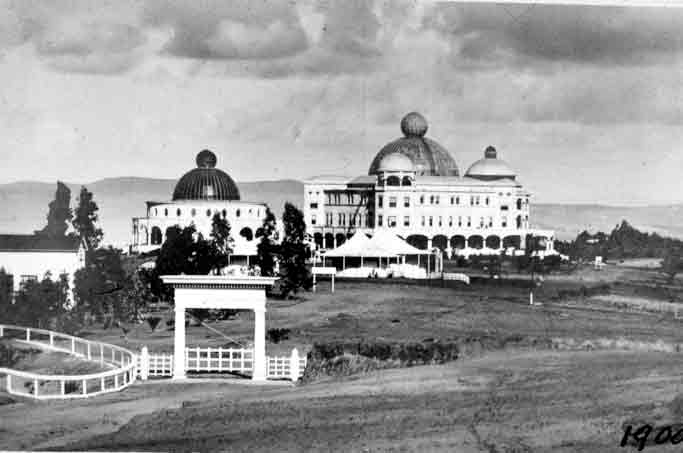
Mieras Hall
Lomaland had public buildings for the entire community and several private homes. The home of Albert G. Spalding, the sporting goods tycoon, was built in 1901. The building combines late-Victorian wooden architecture with historical motifs such as the modified Corinthian column (now shaped like a papyrus leaf) and flattened arches. The amethyst dome was restored by a team of scholars led by Dr. Dwayne Little of the Department of History and Political Science in 1983.
Spalding Residence
Archives, Theosophical Society, Pasadena, California 91109
PLNU# 1 673-3 - 2679.tif
Spalding Residence Features
The wood trim inside the Spalding home was the work of the sculptor Reginald Machell. Machell's Symbolist style attempted to give form to Theosophical principles; the repeated octagonal floor plan oriented around the central dome symbolized the perfection of the universe.
Theosophical Design
The interior decor of the Spalding home was typically late-Victorian. References to classical antiquity are mixed with ornate, manufactured domestic furniture items. This mixture of furnishings is a sharp contrast to the deeply-carved geometry of the doorjambs and the whitewashed purity of the interior dome.
An important component of Theosophical Design was to move in the direction of the arts and crafts reform and a rejection of the overly-decorated interior. Several designers in the emerging modernist movement, such as Piet Mondrian and Wassily Kandisky, were influenced by Theosophy.
Archives, Theosophical Society, Pasadena, California 91109
PLNU# 2 KTDR27.tif
Greek Amphitheatre
Archives, Theosophical Society, Pasadena, California 91109
PLNU# PAN
Built in 1901, this was the first Greek amphitheater in North America. It was used for sporting events and theatrical performances. The tessellated pavement and stoa were added in 1909. The theatre was the site of a number of productions of Greek and Shakespearean dramas.
Group Homes
The educational arm of Lomaland was the Raja Yoga Academy, established in 1901. "Raja Yoga" meant divine union, and the educational goals of the school involved not only intellectual formation but also moral and spiritual development. The Raja Yoga Academy was a boarding school; students lived together in group homes that were know as "Lotus Houses."
This view of the Lotus houses looks south from the Academy Building. Only one of these homes remains on the PLNU campus today; the square-shaped Group Home #9 is visible in the distance at the middle of this image. It currently stands behind Cabrillo Hall at the Dupont Street entrance to campus.
Point Loma Nazarene University is obviously proud of its pagan predecessor, the Theosophical Society. PLNU’s “Campus Tour” gives their student body and prospective students, no warning to have no fellowship with this evil work of darkness, but rather an appreciation for all things Theosophical — Indian spirituality (Hinduism), Raja Yoga, the esoteric principles of spiritual enlightenment and human potential, Gnosticism, etc.
What has been the fruit of Point Loma’s subtle promotion of Theosophy? PLNU is now openly embracing Emergent Church leaders, such as Rob Bell, who brazenly reject Bible doctrine and promote all things Theosophical — Indian spirituality (Hinduism), Yoga, Buddhism, the esoteric principles of spiritual enlightenment and human potential, Gnosticism, etc.
Report On Rob Bell’s Appearance at the Pastor’s Retreat at PLNU
February 23, 2011
“I heard Rob Bell speak this weekend at the chapel service, at the Pastor’s Luncheon and at the Writer’s Symposium. He was true to his unbiblical beliefs at every talk. I heard him compare what Jesus did on the cross (when He, the perfect, sinless sacrifice, gave himself for our sins) to what ordinary people do when we pour ourselves out for our passions. I listened to him discuss ego-centric, tribal-centric, global-centric philosophy at the luncheon for Nazarene pastors and wondered how many of those nodding, affirming pastors knew that this was a reference to the Buddhist philosophy of Ken Wilber who believes that Christianity is fourth on a continuum of nine stages of spiritual development and will soon be replaced by more “enlightened” methods of spirituality? Ken Wilber is one of Rob Bell’s favorite authors. I listened at the Writer’s Symposium as Bell said that this planet is not going to burn (see 2 Pet. 3:10). He also said excitedly that in the next 10 years, the church will rush to the ancient mystics, and I wondered, ‘How about a rush to the Word of God?’ The ancient mystics gathered many of their practices from Buddhism and Hinduism. They were not rooted and grounded in the words and practices of Jesus, the Apostles or the early church, but they are heroes to Rob Bell...
“...in all of my studies and hours of listening to him in his own words, I have never read about or heard him say anything regarding the need for repentance of sins or that Jesus died in our place to take the punishment for our sins.
“Even in Bell’s church’s statement of belief, there is no mention of Christ’s substitutionary atonement or of heaven or hell. One sentence says, ‘God created us to be relational as well and marked us with an identity as his image bearers and a missional calling to serve, care for, and cultivate the earth,’ yet there is no call in the statement to evangelize the lost. Having read the New Testament, I don’t think the Apostles viewed caring for the earth as their primary calling. There is no mention of this theme that we find throughout the New Testament: “(A)nd He Himself bore our sins in His body on the cross, so that we might die to sin and live to righteousness; for by His wounds you were healed.” (1 Pet. 2:24)
A Simplified Version of the New ‘Gospel’
“The new ‘gospel’ below, which I believe accounts for Rob Bell’s theology, explains virtually every concern in the letter we sent about the new provost including the promotion and teaching of open theism, process theology, monastic mystic practices, Darwinian evolution, the tolerance of homosexuality and the maximization of social justice concerns, environmentalism and pacifism versus the minimization of the biblical gospel’s emphasis on sin, the atonement of Christ on the cross, repentance, forgiveness and eternal life either with God in heaven or apart from God in hell...
“The theology of this false gospel is based on the theories of Buddhist philosophers, Ken Wilber, the worldviews of Stanley Grenz, Wolfhart Pannenberg, LeRon Shults and in German theologian Jurgen Moltmann’s ‘theology of hope’, developed from the philosophy of Friedrich Hegel, Karl Barth and Rudolph Bultman.
“In this ‘gospel’, the universe is a part of God (panentheism) or is God (pantheism) and is continually evolving into better forms. God, who contains the universe and everything in it, also evolves and stands in the future pulling everything toward Himself. He is immanently involved in the present world creating and causing it to move toward the future world. As all things (both physical and spiritual) evolve, the universe will continue to improve until a sort of utopia is finally achieved. Humans further this evolution toward God and this utopia by doing two things:
1. Good works – helping to eradicate poverty and suffering, working to restore the environment, calling for an end to war, etc.
2. Engaging in contemplative, mystical experiences that ‘connect’ one to God in higher ways than the intellect will allow.
“Thus, everyone who adheres to these practices achieves salvation by working together to help the world and everything in it evolve. In this theology, Scripture does not convey a fixed meaning determined by Holy Spirit-inspired authors. Instead, spiritual experiences become the true source of meaning for individuals and groups of people. Therefore, God’s commands are no longer universally binding. Christ was crucified not because he was the sacrifice for our sins but because the world rejected His message of love. According to this view, the resurrection is merely a view of history with a hopeful future. Hell and heaven are not experienced in the hereafter but are part of the human condition in this life. There is no need for repentance of sins and no future judgment. Christ may be the best way to God, but He is not the only way. Everyone will eventually be saved and live together on this present earth in peace and unity.
The apostasy of Point Loma Nazarene University did not occur spontaneously, from some inexplicable cause. PLNU carries the genetic traits of the heretical progenitor it now resembles — the Theosophical Society.
“Ye shall know them by their fruits. Do men gather grapes of thorns, or figs of thistles? Even so every good tree bringeth forth good fruit; but a corrupt tree bringeth forth evil fruit. A good tree cannot bring forth evil fruit, neither can a corrupt tree bring forth good fruit... Wherefore by their fruits ye shall know them.” Matt. 7:16-20
The Lord Jesus was not giving His disciples a lesson on horticulture, but a spiritual principle by which to form their opinions of spiritual leaders: “Beware of false prophets, which come to you in sheep’s clothing, but inwardly they are ravening wolves.” (v.15) Since the spiritual tree of Theosophy is corrupt, we may safely assume that the spiritual fruit it has produced — PLNU and its offspring, James Dobson and Focus on the Family — have the same spiritual nature.
See also:
FOCUS ON THE FAMILY ALLIANCE WITH MORMONS, MUSLIMS, HINDUS & JEWS
Focus on the Family: MainstrEaming Mormonism
Focus on the Family & Quest International
Social Salvation through Character Education
Funded by Rockefeller/CarnegiE & Preached by Dr. Dobson
*Fair Use Provision:
Reproduction of copyrighted material is permitted for purposes of criticism, comment and research under the Fair Use Provision of the U.S. Copyright Law, which states:
§ 107. Limitations on exclusive rights: Fair use
Notwithstanding the provisions of sections 106 and 106A, the fair use of a copyrighted work, including such use by reproduction in copies or phonorecords or by any other means specified by that section, for purposes such as criticism, comment, news reporting, teaching (including multiple copies for classroom use), scholarship, or research, is not an infringement of copyright. In determining whether the use made of a work in any particular case is a fair use the factors to be considered shall include —
(1) the purpose and character of the use, including whether such use is of a commercial nature or is for nonprofit educational purposes;
(2) the nature of the copyrighted work;
(3) the amount and substantiality of the portion used in relation to the copyrighted work as a whole; and
(4) the effect of the use upon the potential market for or value of the copyrighted work.
